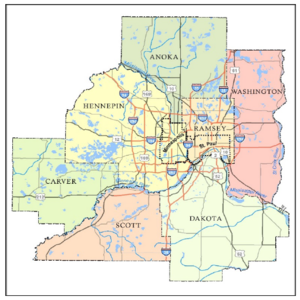
TCMA Chloride TMDL - Executive Summary
Executive Summary
The Twin Cities 7-county metropolitan area (TCMA) includes 186 cities and townships and a population of approximately 3,000,000 people. It covers approximately 3,000 square miles with about one-third in urbanized areas. It is a vibrant and growing community. The area is fortunate to be home to nearly 1,000 lakes and wetlands, small streams and large rivers, as well as shallow and deep groundwater aquifers. These water resources hold high value to the community and visitors to the area.
The Twin Cities receives approximately 54 inches of snow each year on average. The thousands of miles of streets and highways in the TCMA, along with parking lots and sidewalks, must be maintained to provide safe conditions throughout the winter. Winter maintenance of these surfaces currently relies heavily on the use of salt, primarily sodium chloride (NaCl), to prevent ice build-up and remove ice where it has formed. The chemical properties of sodium chloride make it effective at melting ice, but these properties also result in the chloride dissolving in water and persisting in the environment. The dissolved chloride moves with the melted snow and ice, largely during spring warm-ups, and ends up in the water resources.
Residential water softener use is also a significant source of chloride. Residential water softeners use chloride to remove hardness, which is typically caused by high levels of calcium and/or magnesium. In areas with hard water, residential water softeners which use salt are common. The chloride from water softeners makes its way to the environment either through discharge to a septic system or by delivery to a municipal wastewater treatment plant (WWTP). Chloride is not removed from wastewater using treatment methods.
Elevated chloride concentrations have been found in waterbodies throughout the TCMA. At levels exceeding the WQS, chloride is toxic to aquatic life. Water samples from lakes, wetlands, streams and groundwater show high chloride levels in urban areas across the state. While monitoring has only been conducted for about 10% of the surface waterbodies in the TCMA, the available data indicates 39 waterbodies in the TCMA currently exceed chloride levels protective of the aquatic community. Two of these impaired waterbodies, Shingle Creek and Nine Mile Creek, already have approved Total Maximum Daily Loads (TMDLs). This report presents the development of the TMDLs for the remaining 37 waterbodies in the TCMA impaired for chloride.
A TMDL quantifies the allowable pollutant loading to a lake or stream that will result in water quality standards being attained. The water quality target (WQT) for the TMDLs was set to the chronic water quality criterion for chloride of 230 mg/L. The total allowable load, or TMDL, is allocated to the various Twin Cities Metropolitan Area (TCMA) sources contributing chloride as well as consideration of a margin of safety (MOS) and reserve capacity (RC). A simple 0-dimensional, steady-state modeling approach was selected through consultation with a Technical Advisory Committee for calculating the allowable load from runoff, including permitted Municipal Separate Storm Sewer System (MS4) areas and non-permitted areas. This approach assumes that chloride from winter maintenance activities and all other sources eventually makes its way to surface waterbodies through runoff. This approach was chosen for the following reasons: 1) chloride is a conservative substance and is in the dissolved phase in the water environment; therefore, complex fate and transport assessments are not needed; 2) determining the time for a system to respond to reduced chloride loads was not necessary to inform the TMDL or Chloride Management Plan (CMP); and 3) the large number of lakes and streams needing a TMDL and the limited data available for a significant portion of them prohibited a more complex approach. This approach assumes eventual complete flushing in an impaired waterbody over the long-term.
Deicing salt is the most common and the preferred method for meeting the public’s winter travel expectations. There is currently no environmentally safe and cost-effective alternative that is effective at melting ice. Therefore, continued use of salt as the predominant deicing agent for public safety in the TCMA is expected. Setting a specific chloride load reduction target for each individual winter maintenance chloride source is challenging, as is measuring actual chloride loads entering our surface and groundwater from deicing salt and other nonpoint sources in the TCMA. Therefore, priority should be put on improving winter maintenance practices to use only a minimal amount of salt, also referred to as smart salting, across the entire TCMA. With these considerations in mind, the implementation approach for achieving the TMDLs and protecting all waters in the TCMA is to focus on performance of improved winter maintenance practices as well as continuing to monitor trends in local waterbodies. The Minnesota Pollution Control Agency (MPCA) and stakeholders worked together to develop a plan to achieve the TCMA chloride TMDLs. The CMP incorporates water quality assessment, source identification, implementation strategies, monitoring recommendations, and measurement and tracking of results into a performance-based adaptive approach for the TCMA. The goal of the plan is to develop the framework to assist local partners in minimizing salt (chloride) use and provide safe and desirable conditions for the public. The CMP also includes performance-based strategies to reduce salt (chloride) from other sources such as water softening, wastewater discharges, and agricultural sources.
This page was last edited on 23 November 2022, at 14:59.
